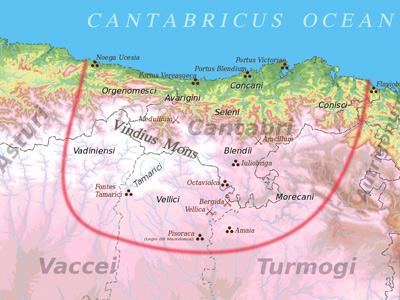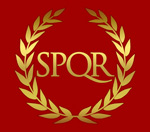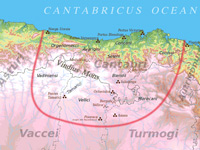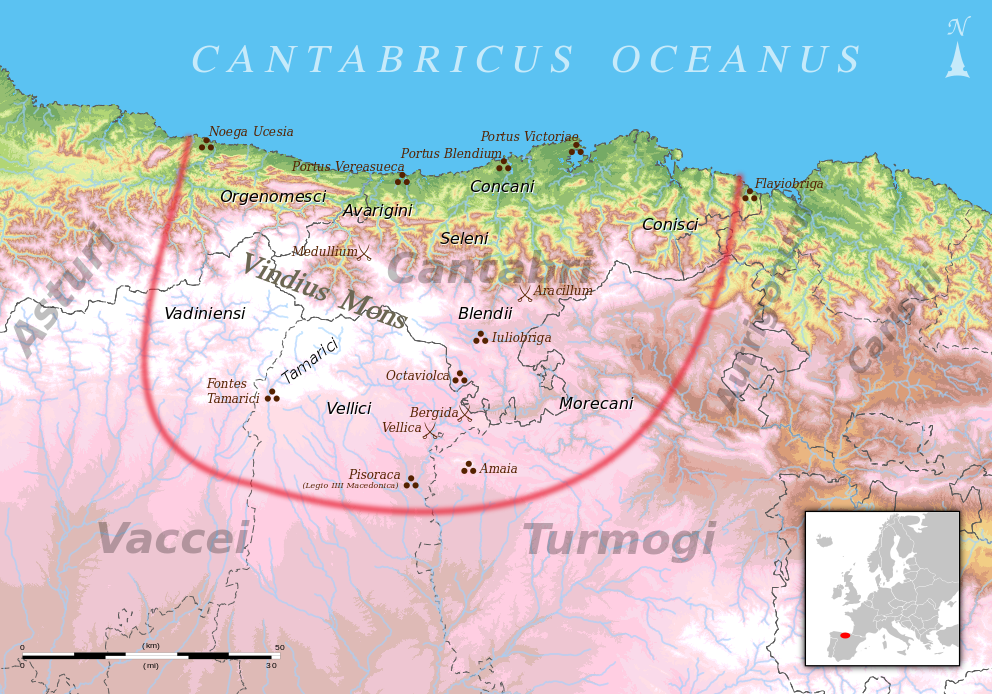Cantabrian Wars (29–19 BC)

Bellum Asturicum
The Astures joined the Cantabri in a common defense. In spring 25 BC, there were three Roman legions established near the Astura River (modern Esla River), with troops from the Tarraconensis. According to contemporary Roman historian Florus in his Epitome of Roman History, the armies of the Astures Transmontani came down from their snow-covered mountains (which is perfectly possible in the Picos de Europa in spring) and settled near the Astura River, getting ready to take the three Roman winter camps.
However, the brigaecini (Astures Cismontani) peoples of the Benavente region informed Augustus on their intentions. Augustus gave Brigantum, the camp of Augustan Asturica, to the Brigaeci as a reward for their help. Additionally, he shared out land in the plains to the allies. His general Carisius attacked the Astur armies (probably commanded by Gausón), forcing them to take refuge in the fortified city of Lancia, the most important Astures Cismontani fort according to Florus.
Once Lancia was besieged, the Astur armies took refuge in the Mons Medullius (some scholars locate it at Las Médulas basing their opinions on Florus who specifically names the site in his history of Rome). The Roman legions besieged the mountain, building a fifteen-mile-long moat and ditch. According to Orosius, the Cantabri soldiers preferred to commit suicide with their own weapons and yew tree poison rather than surrender.
A year after his arrival, Augustus had to retire to Tarragona, presumably because of sickness. The conflict, however, lasted more than ten years (it serves as a reference that the Roman Empire The Roman Empire was the post-Republican period of ancient Rome. As a polity, it included large territorial holdings around the Mediterranean Sea in Europe, North Africa, and Western Asia, and was ruled by emperors. The first two centuries of the Roman Empire saw a period of unprecedented stability and prosperity known as the Pax Romana ('Roman Peace'). The Empire was later ruled by multiple emperors who shared control over the Western Roman Empire and the Eastern Roman Empire. conquered all of Gallaecia in less than seven years). It was one of only two campaigns directed personally by Augustus against barbarians, the other being the one against the Illyrians from 35 to 33 BC.
The Roman Empire was the post-Republican period of ancient Rome. As a polity, it included large territorial holdings around the Mediterranean Sea in Europe, North Africa, and Western Asia, and was ruled by emperors. The first two centuries of the Roman Empire saw a period of unprecedented stability and prosperity known as the Pax Romana ('Roman Peace'). The Empire was later ruled by multiple emperors who shared control over the Western Roman Empire and the Eastern Roman Empire. conquered all of Gallaecia in less than seven years). It was one of only two campaigns directed personally by Augustus against barbarians, the other being the one against the Illyrians from 35 to 33 BC.
HISTORY

RESOURCES
This article uses material from the Wikipedia article "Cantabrian Wars", which is released under the Creative Commons Attribution-Share-Alike License 3.0.
© Stories Preschool. All Rights Reserved.










